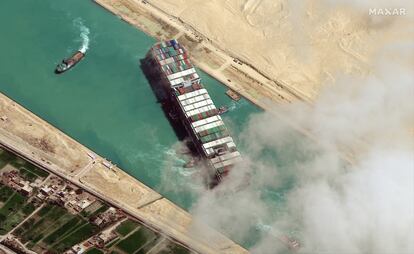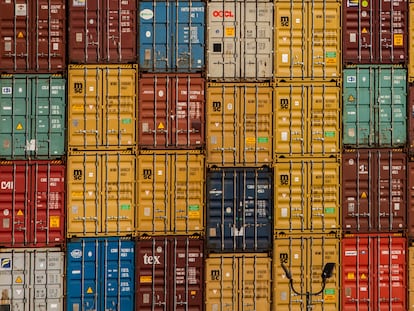Aftermath of the tariff war: The possible end of the WTO, billion-dollar losses and poorer nations
The rise of protectionism and the division of the planet into two rival economic blocs would reduce world GDP by 7%, according to various international organizations

“Winter is coming.” The phrase, which one might associate with the legendary television series Game of Thrones, figured more recently among the remarks of a Norwegian representative at a November 2019 meeting of the World Trade Organization (WTO). Five years later, those words seem to resonate, albeit under different global circumstances. There has been a retreat from free trade and in its place, the world has been witness to a rise in protectionism that could end in the planet’s division into rival economic blocs. Preludes to that outcome can be seen in the tense relationship of the European Union with China, due to tariffs imposed by Brussels on electric cars manufactured by the Asian country. The situation has escalated to the point that Spanish Prime Minister Pedro Sánchez suggested this week that the European Commission reconsider its position on the issue in order to avoid “another trade war.”
Should tariff disputes continue and fragmentation progress, the WTO could tumble, incurring monetary losses into the trillions. The International Monetary Fund (IMF) estimates a reduction in worldwide gross domestic product (GDP) of up to 7% in the long term, the equivalent of about $7.4 trillion. That is the combined size of the French and German economies. A recent report by Oxford Economics and the International Chamber of Commerce found that the hypothetical dissolution of the WTO would reduce the GDP of all world regions between 1 and 6.5% by 2030.
Such numbers underscore the devastating effects that global economic fragmentation could have. In recent years, geopolitical differences, the Covid pandemic and the inflation crisis have led to an intensification of barriers to trade and investment. Global Trade Alert estimates that within five years, there have been almost 27,000 government interventions against international trade, while the United Nations reports a marked drop in European and U.S. investment in China. The agency has also warned that both companies and governments are more reluctant to share technological advances and integrate supply chains with countries they consider geopolitical enemies. The battle that has been raging since 2018 between Beijing and Washington D.C. is another clear example, having reached a new decibel with the recently imposed 100% tax on Chinese electric vehicles that has been announced by Joe Biden’s administration.
That measure can be read as a de facto exclusion of Chinese manufacturers from the U.S. market. This has even been hinted at by the European Commission, which has attempted to distance itself from such initiatives even after initially following in their footsteps, increasing taxes up to 48% on vehicle imports from Beijing. That decision, according to Brussels, was taken to level the playing field for European manufacturers versus the Asian giant — but not to drive China out of the market, as will likely happen after the United States’ gambit. Analysts believe that this could be just the beginning of an escalation in trade tensions between the blocs, as green and tech companies lag behind competitors. Brussels recently presented the most detailed document ever seen on how Chinese state subsidies affect regional producers. “This is a report to lay the groundwork and show how and why Europe is changing its policies,” said one of the Brussels experts on the subject.
There is doubt as to whether the benefits of this rise of geopolitical rivalries will outflank its negative effects. Economists and international organizations warn that the greater this deglobalization becomes, the greater its costs. The WTO found in 2022 that if the world divided into two distinct trade blocs, GDP would fall by 5%. The IMF has spoken of an impact on global production from 0.2 to 7% of worldwide GDP in the case of severe trade fragmentation. Add to that the blockage of scientific advances — the so-called “technological decoupling” — and losses could soar to 12% in some countries. The impact could be so great that it could put pressure on the global monetary system and lead to “financial regionalization.”
Estimates by Oxford Economics predict a long-term drop in annual GDP of more than 5% among developing countries if this rise in protectionism leads to the demise of the WTO. Africa and South Asia would be the regions hardest hit by such an economic slowdown, with potential losses rising above 6% of GDP. The damage, however, would not be limited to developing countries; major powers would also be weighed down by the vulnerability of the global supply chain and particularly exposed in times of crisis, such as another pandemic or war in Ukraine. According to these calculations, Europe would see its productivity fall by around 1.5%.
Beyond these figures, there are latent security, nutritional and energy risks. The Russian blockade of Ukrainian wheat exports in 2022 was a key factor behind the sudden 37% rise in prices around the world of the grain. That drove a price hike for other foods that has put many countries that depend on their supply on high alert. The curb on Russian gas exports has also led to the biggest global energy crisis ever seen, which gives one an idea of the practical impact of trade fragmentation.
Sign up for our weekly newsletter to get more English-language news coverage from EL PAÍS USA Edition
Tu suscripción se está usando en otro dispositivo
¿Quieres añadir otro usuario a tu suscripción?
Si continúas leyendo en este dispositivo, no se podrá leer en el otro.
FlechaTu suscripción se está usando en otro dispositivo y solo puedes acceder a EL PAÍS desde un dispositivo a la vez.
Si quieres compartir tu cuenta, cambia tu suscripción a la modalidad Premium, así podrás añadir otro usuario. Cada uno accederá con su propia cuenta de email, lo que os permitirá personalizar vuestra experiencia en EL PAÍS.
¿Tienes una suscripción de empresa? Accede aquí para contratar más cuentas.
En el caso de no saber quién está usando tu cuenta, te recomendamos cambiar tu contraseña aquí.
Si decides continuar compartiendo tu cuenta, este mensaje se mostrará en tu dispositivo y en el de la otra persona que está usando tu cuenta de forma indefinida, afectando a tu experiencia de lectura. Puedes consultar aquí los términos y condiciones de la suscripción digital.
More information
Archived In
Últimas noticias
Welcome to the post-religion era: The idea of Christianity as the absolute truth has become obsolete
‘I thought you would like it’: The risky sexual practice popularized by TV shows and TikTok
The digitalization of tourism: ‘They promise experiences and gave us the worst possible one’
Mexican peso defies uncertainty with forecasts of a new period of stability in 2026
Most viewed
- Sinaloa Cartel war is taking its toll on Los Chapitos
- Reinhard Genzel, Nobel laureate in physics: ‘One-minute videos will never give you the truth’
- Oona Chaplin: ‘I told James Cameron that I was living in a treehouse and starting a permaculture project with a friend’
- Why the price of coffee has skyrocketed: from Brazilian plantations to specialty coffee houses
- Silver prices are going crazy: This is what’s fueling the rally










































